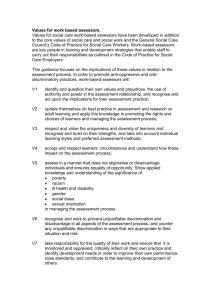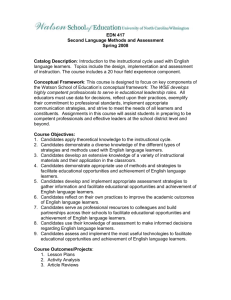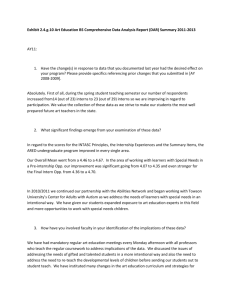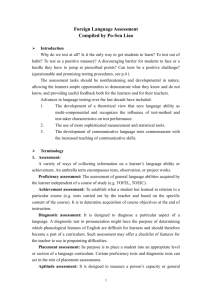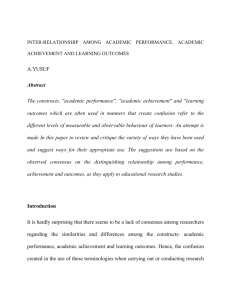CETT Applied Linguistics Lecture Series___Lecture 12
advertisement
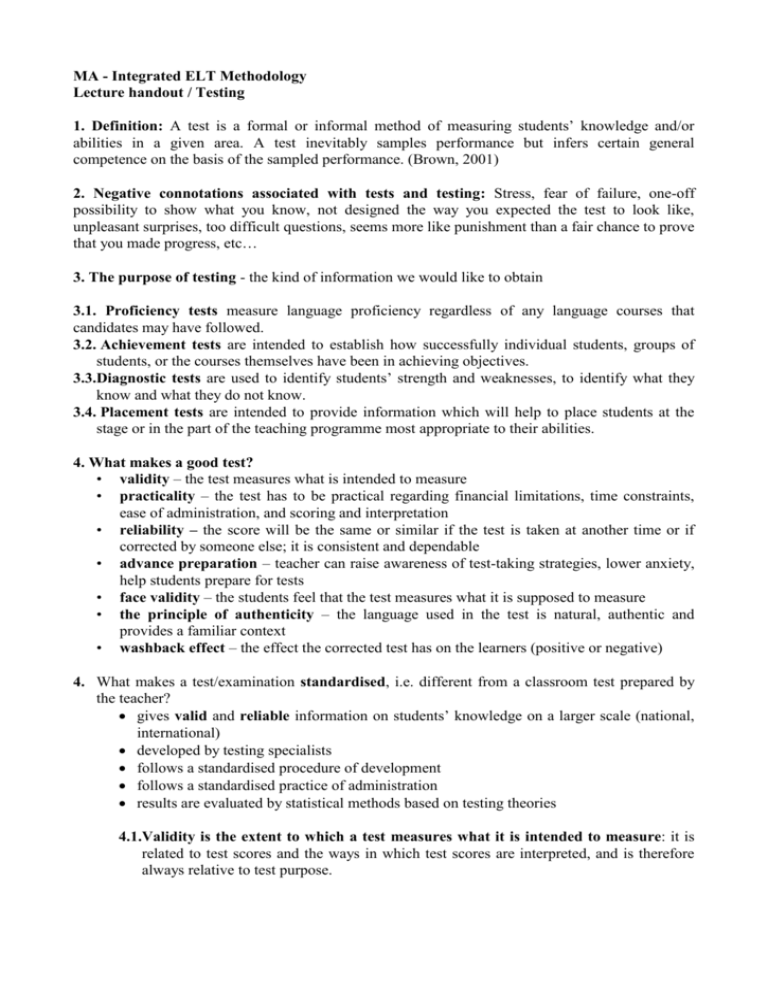
MA - Integrated ELT Methodology Lecture handout / Testing 1. Definition: A test is a formal or informal method of measuring students’ knowledge and/or abilities in a given area. A test inevitably samples performance but infers certain general competence on the basis of the sampled performance. (Brown, 2001) 2. Negative connotations associated with tests and testing: Stress, fear of failure, one-off possibility to show what you know, not designed the way you expected the test to look like, unpleasant surprises, too difficult questions, seems more like punishment than a fair chance to prove that you made progress, etc… 3. The purpose of testing - the kind of information we would like to obtain 3.1. Proficiency tests measure language proficiency regardless of any language courses that candidates may have followed. 3.2. Achievement tests are intended to establish how successfully individual students, groups of students, or the courses themselves have been in achieving objectives. 3.3.Diagnostic tests are used to identify students’ strength and weaknesses, to identify what they know and what they do not know. 3.4. Placement tests are intended to provide information which will help to place students at the stage or in the part of the teaching programme most appropriate to their abilities. 4. What makes a good test? • validity – the test measures what is intended to measure • practicality – the test has to be practical regarding financial limitations, time constraints, ease of administration, and scoring and interpretation • reliability – the score will be the same or similar if the test is taken at another time or if corrected by someone else; it is consistent and dependable • advance preparation – teacher can raise awareness of test-taking strategies, lower anxiety, help students prepare for tests • face validity – the students feel that the test measures what it is supposed to measure • the principle of authenticity – the language used in the test is natural, authentic and provides a familiar context • washback effect – the effect the corrected test has on the learners (positive or negative) 4. What makes a test/examination standardised, i.e. different from a classroom test prepared by the teacher? gives valid and reliable information on students’ knowledge on a larger scale (national, international) developed by testing specialists follows a standardised procedure of development follows a standardised practice of administration results are evaluated by statistical methods based on testing theories 4.1.Validity is the extent to which a test measures what it is intended to measure: it is related to test scores and the ways in which test scores are interpreted, and is therefore always relative to test purpose. 4.2. Reliability is the extent to which the test scores are consistent: if the candidates took the same test again tomorrow after taking it today, would they get the same result (assuming no change in their ability)? 5. The testing cycle 5.1.Design and pre-testing Write specifications (who wants to know what about whom, why and when?) Design test (tasks, procedures, marking scheme, criteria, training of assessors) Pre-test (representative population, feedback) Analyse pre-test results (standard setting) Revise test Print and despatch test materials 5.2.The test goes ‘live’ Train and monitor markers and assessors Administer test to candidates 5.3.Analysis and evaluation Analyse test results (statistical analysis, feedback, observations) Report results Evaluate test and procedures 6. Why do we need standardised tests? - The educational context (European tendencies & Hungary) shift from centrally controlled input towards a more flexible decentralised system introduction of the National Core Curriculum (identifying ‘what’ to teach giving freedom to the ‘how’- content control), introduction of “Frame curricula” (between NCC and the local curricula) need to control the output more emphasis on evaluation procedures, standardisation 7. How can a teacher use any of these principles in the classroom? How am I to decide what to test my students on? How can my tests be more than a set of improvised questions at the end of a course? How can I better select what to include in my tests? Sampling: the test constructor must sample what has been taught. What? o the course content o the course objective o student errors How? o principled choice o mechanical choice Tests as compromises They are compromises by sample: we cannot - should not - include everything in our tests. They are compromises by method: there might be something in our sampled list of desirables which we realise we are unable to test. Direct/task-based tests vs. indirect/discrete point tests The driving test is based on a task and is direct. The learner driver has to do a task, which is very similar to the real thing. A multiple choice grammar test is based on a number of separate discrete points of grammar, and is indirect because what the student has to do is rather remotely like the real thing. 7. Ideas for designing test: Teachers who run parallel educational programmes should develop tests jointly. Get your colleagues to do your test beforehand and ask them to comment. Get some other students to do your test before your students do it. Look after clarity of the questions. In the light of trials and criticism be prepared to drop the items you believed were your best. Write specifications for your test too. You will forget most of your decisions and methodology by the time you want to use it again. Train each other. Use scripts from the trials for the written and video for the oral tests. At least sit in on each other's sessions. 8. Alternative assessment and feedback: ”While tests can be used as a bolt-on procedure at end-points in a learning programme, assessment is integral to the whole process of teaching and learning. It is the means by which students’ language learning development and achievement are monitored over time.” (Hedge, 2000) • • • • • • • • • • • • • 8.1. Aims of assessment: to help the teacher’s planning of further classroom work (formative assessment) to measure and document learner achievement to focus on mistakes /difficulties /weaknesses to indicate strengths / achievements to motivate/encourage learners to give content feedback to give grades as expected by school and parents to help learners assess their own progress over time (self-assessment) to keep track of learners’ progress on a regular basis (continuous assessment) 8.2. Examples of alternative assessment methods: Tests that actually give real feedback with narrative evaluation to encourage learners and help them see their strength and areas for improvement Observation-driven assessment Portfolios Learners’ personal diaries







